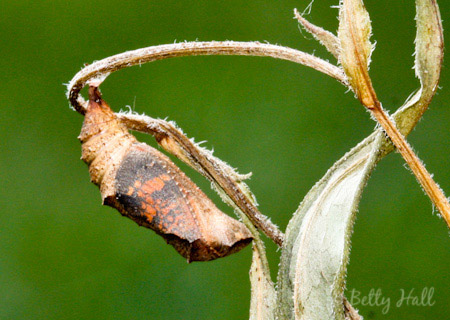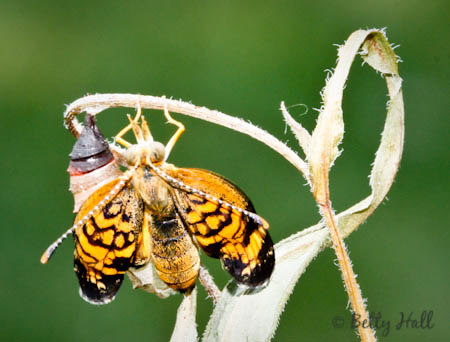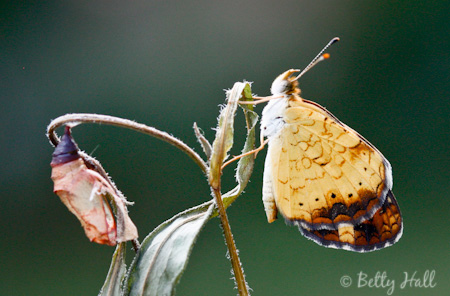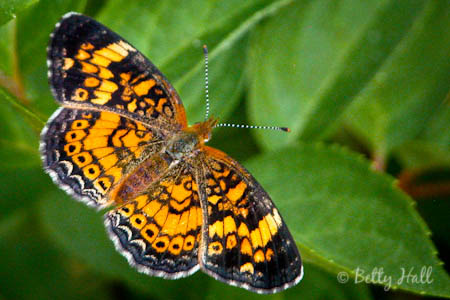It’s easy to get excited about big butterflies such as Monarchs and Swallowtails. It takes more effort to see and appreciate the smaller ones, but I find them just as exciting.
My friend, Connie May, has a keen eye for small things, especially caterpillars, which she often gives to me to photograph and raise. She recently discovered a half-inch Pearl Crescent (Phyciodes tharos) chrysalis while pulling weeds and gave it to me.
The next morning I saw orange and black wing markings showing through the previously opaque chrysalis, and suspected the butterfly would soon emerge.

With camera ready, I was watching when “poof” the magic happened and the butterfly appeared.

The wings gradually lengthened and after a minute the butterfly became still while the fully formed wings hardened.

In a couple of hours, it was ready to fly.
 Crescents get their name from the markings near the bottom of the hind wings. At three-fourths inch wide, Pearl Crescents are one of our smaller butterflies. They are also one of the most common in North America.
Crescents get their name from the markings near the bottom of the hind wings. At three-fourths inch wide, Pearl Crescents are one of our smaller butterflies. They are also one of the most common in North America.
A great way to encourage Crescents is to plant native asters. They are the only plants on which Pearl Crescents lay their eggs. As an added benefit, the beautiful aster blossoms are an excellent source of nectar for many fall butterflies.
I feel fortunate that Connie discovered the tiny chrysalis and gave it to me, and that I was able to see it emerge and set it free in the backyard. As to butterflies, large or small, I like them all.


Nature is amazing, designs we could never imagine. Beautiful even in miniature.
Doris, I totally agree.
aaahhh. so lovely. now i have to find a pearl crescent caterpillar for you to photograph! glad to know about the “crescent” name…that should help me remember the name. someday i hope to learn to i.d. my butterflies as well as you can. love, connie
Yes, I’d be delighted to photograph a Pearl Crescent caterpillar. It will be tiny and I’m sending best wishes for you to find one. And some day I hope to be as good at finding caterpillars as you are.
Gorgeous photos Betty. Looks like you got this one at the perfect time! I will be sure to check my asters. We were thrilled to find our first caterpillars on the parsley yesterday. Thank you for the extra food. Next year I will have to plant more!
Regina, I’m delighted you found the caterpillars. Have plenty of parsley and glad to share.
very good Betty, Josie will enjoy cmp
Carter, every granddaughter should be so lucky to have a grandpa that encourages them in their interests, including nature.
As usual, amazing photos! I learn so much from your blogs. I do have two different types of aster in my yard but being still rather new to butterflying and still learning, wasn’t aware that it was host plant for the pearl crescent ; ) “Flying Flowers” – never a dull moment ; )
Chris
Chris, I’m still learning, too, and don’t see an end in sight. So welcome to the club.
I’ve just noticed these butterflies this year — I posted on them here.
http://www.acrossthepage.net/2011/08/beauty-on-the-wing/
Native asters. I’m putting that on the list to plant next year for sure!
Janet, I just checked your website and felt somewhat like I was Alice dropping into the rabbit hole. Meant to quickly check it out – ended up staying for quite a while. The butterfly photos are great. I also enjoyed the book reviews of Girl of ” Limberlost”, and “Fidelity”, among others.. Will definitely check on “It’s a Butterfly’s Life”. You inspire me to manage more time for reading. Keep up the good work.
Nice shots, Betty! So hard to capture the magical moment when the butterfly emerges, but you got it! Good job. These little guys remind me of the Silvery Checkerspots I found last year for the first time on the yellow Verbesina. Still don’t know how tell these 2 apart! You’ll have to give me some tips!!
Thanks, Richard. Yes, not easy to tell those two apart. The Silvery Checkerspots are slightly larger. However, my primary way of telling them apart are the small white (or ‘silvery’) spots on the top of the Checkerspots’ hind wings while the spots on the Pearl Crescents top hind wings are solid and dark. Hope that helps.